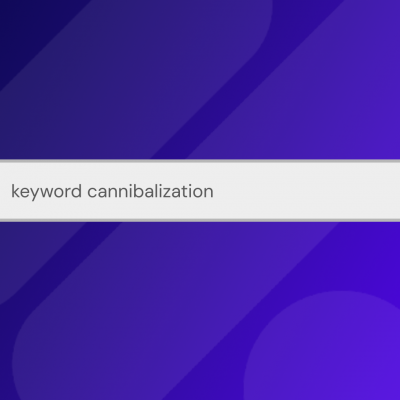Often overlooked due to the siloed approach of these two channels, a total search approach is one of the most effective ways to avoid keyword cannibalization and drive total search efficiencies.
What is Paid and Organic Keyword Cannibalization?
Also referred to as PPC and SEO cannibalization, it refers to instances where paid search and organic search target the same keyword, meaning that they effectively compete for clicks and traffic from search. If not managed, the net result is diminished organic traffic and paid search budget inefficiencies.
Why is Keyword Cannibalization So Bad?
There’s a few different ways that keyword cannibalization plays out, but the most common are:
- Increased paid search costs and lower total search return on investment (ROI)I: If a PPC campaign bids on keywords that a website ranks well for organically, you may start paying for clicks that were free through organic search, resulting in increased advertising costs and a lower ROI. This is commonly seen when a company bids on its own brand and no competition exists from other bidders.
- Mismatched user intent: When an ad appears above organic results for the same keyword, users might click on the ad instead of the organic listing and arrive on a PPC landing page. While this might seem beneficial since the traffic is still directed to the same website, the PPC landing page may not offer the best content for the desired user intent. This can have a knock on effect of lowering the conversion rate. This is often the case with longtail keywords.
- SEO efforts undervalued: High-performing PPC ads might overshadow organic results, potentially reducing the visibility and CTR rates of organic listings. This can diminish the perceived value of continuing SEO efforts for those keywords, which may be harmful in the long run.
- Wasted paid search budgets. Paid search campaigns may overinvest in keywords that drive traffic organically, meaning missed opportunities to target valuable, high converting keywords where organic does not perform.
However, the concept of keyword ‘cannibalization’ can be a misnomer as it’s not always a zero sum game. Google research highlighted some interesting benefits of being visible on paid and organic search results:
- On smartphones, the top position (ad) in combination with an organic result leads to highest volume of clicks for a brand
- Users associate the top position with well-known, popular and relevant brands
- 1+1=3: The combination of paid and organic results has the strongest impact on recall and consideration
These nuances are exactly why brands need to consider a strategy for managing keyword cannibalization.
When Does Keyword Cannibalization Occur?
Keyword cannibalization occurs when paid and organic teams operate in silos with little to no visibility on each other’s goals and KPIs. It’s also common in companies with a low digital maturation, where technology to automate a total search strategy is not employed. Unfettered and automated bidding strategies like PMax can also increase keyword overlap.
How to Identify Keyword Cannibalization?
Identifying the first signs of paid and organic keyword cannibalization can be crucial for addressing the issue before it significantly impacts performance and costs. Here are some early indicators:
- Decrease in organic traffic: If you notice an unexpected decrease in organic traffic yet your positions are stable, it could be a sign of cannibalization. Be sure to rule out seasonality or the impact of changing SERP layouts (including SGE). Look out for correlations between organic traffic decreasing and paid traffic increasing on a page level, and check if there has been any change to PPC budgets or bidding strategies.
- Decrease in organic CTR: A decline in organic CTR alongside stable keyword positions and unchanged or increased paid search CTR for the same keywords, might suggest that PPC ads are overshadowing organic results.
- Increase in paid search conversions while total search conversations remain the same: This may indicate that you’re paying for conversions that were previously free.
- PPC budget efficiency: You’re spending more on paid search without a corresponding increase in overall performance or revenue. This could be a symptom of internal competition between your paid and organic search strategies.
How to Mitigate Keyword Cannibalization?
There are a few well documented approaches to mitigating paid and organic search keyword cannibalization, but they are limited in their effectiveness as they are largely reactionary, consider a very limited number of variables, ignore the speed at which the search landscape changes (from competition to algorithm and SERP changes) and are not optimized according to the metrics that actually count – Total ROAS and Total Search Margin.
Keyword segmentation or filtering out keywords that perform well on organic using negative keyword lists, is one such method, however this does not take into account that organic rankings, competition and SERPs are constantly changing, nor the performance increase that can be gained from being visible via paid and organic results. Also, this approach mostly relies on organic rankings to segment keyword lists, and completely misses all the other variables that are important – Competition, CPC, CTR, CR, AOV and ROAS. In summary, it’s a sweeping recommendation that can actually be harmful in the long run.
The key to driving real efficiencies and value for total search lies in incrementality, i.e. identifying the point where an additional penny spent no longer nets more than a penny back. This level of detail can only be achieved through having a total view of organic and search performance for all queries, every day. On the organic side, this includes query level Impression, Click and Position data from Google Search Console, and on the paid side, the same plus revenue metrics that are not available in Google Search Console, including CR and AOV.
Leveraging this volume of data is only possible through automation and machine learning.
How We Delivered Incrementality for Superdrug
We used our bespoke tool, Seamless Search, to assess key data points and model a picture of total revenue for each keyword based on this simple premise – will paid or organic provide the most valuable click?
Seamless Search provided data to inform a total search strategy, which helped Superdrug identify where improvements in organic position and CTR could reduce ad spend, i.e. where ad spend could be saved to achieve the same amount of revenue. This helped assign a monetary value to SEO in terms of money saved (instead of revenue earned). As a result, Superdrug saw a +102% higher total ROAS from keywords, and drove a £53.3k increment return from Total Search.
In summary, Seamless Search provided the automation and data to help identify keyword cannibalization that was harming total search performance and provided a reporting view to help paid and organic complement and not compete with each other, optimizing overall search performance and maximizing the effectiveness of digital marketing budgets.
How We Delivered Incrementality for Imperial London Hotels
We used our bespoke tool, Seamless Search – pulling keyword level data from Google Ads & Search Console, modelling a picture of total revenue by keyword achieved and then, through a bespoke ML model, automated Paid bidding decisions to maximize ‘Total Search’ incremental revenues given a search terms organic position.
Seamless Search helped Imperial London Hotels deliver a 73% increase in revenue vs pre-campaign implementation. This resulted in a 96% increase in Total Search Revenue YoY.
—
For more information on how you can drive incrementality, marketing effectiveness and grow your business check out our latest playbook:



